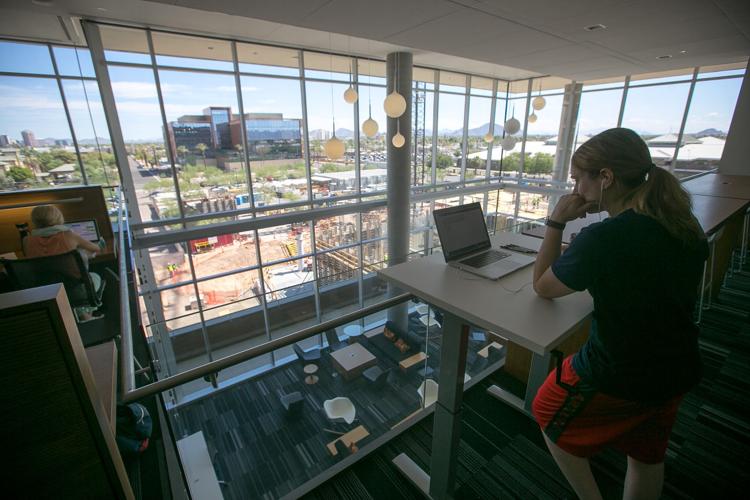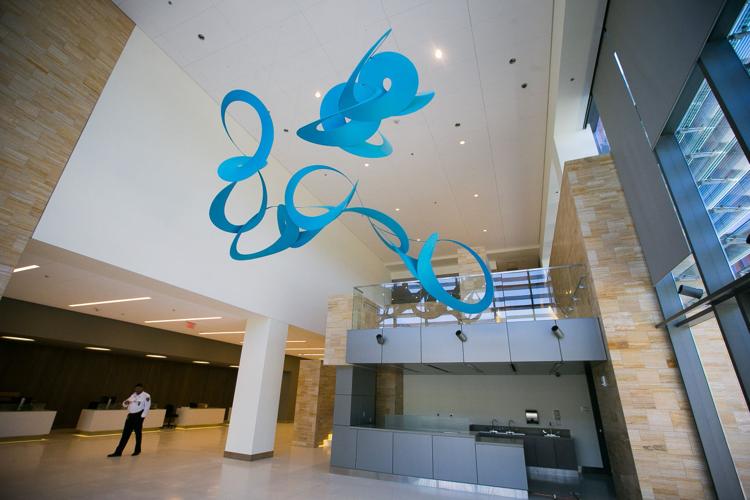The University of Arizona has a large and expanding health and science presence worth nearly $1 billion per year on prime property in downtown Phoenix.
The Phoenix Biomedical Campus land is owned by the city of Phoenix and all three state-funded Arizona universities have functions there. But it’s the UA that dominates the 30-acre property, having invested nearly $450 million in campus building projects.
The anchor of the campus is the UA College of Medicine-Phoenix, which opened in 2007.
The UA is set to expand its Phoenix footprint later this summer with the opening of a gleaming new 230,000-square-foot, $100 million University of Arizona Cancer Center at Dignity Health St. Joseph’s Hospital and Medical Center clinic.
The outpatient cancer clinic, projected to treat 60,000 patients per year, is the only UA medical facility that was not part of the deal when Phoenix-based Banner Health acquired the Tucson-based UA Health Network in March.
Banner is expected to have a future presence on the Phoenix Biomedical Campus in a partnership with the UA.
City of Phoenix
and Banner
Last month, Phoenix Mayor Greg Stanton announced that the city and the UA had entered into an agreement to do further expansion with Banner Health on five undeveloped acres on the biomedical campus.
“Certainly the University of Arizona is interested in increasing research capabilities on that campus. And clearly Banner is interested in increasing clinical opportunities on that campus,” said Kathy Bollinger, president of Banner-University Medicine.
“Working with Mayor Stanton’s planner, we will design a solution and therefore a size that meets the needs. Mayor Stanton is very excited about it, as you might imagine, because he’s all about Phoenix economic development.”
With its acquisition of the UA Health Network, nonprofit Banner Health became the state’s largest private employer.
“There’s a lot of development happening in the central (Phoenix downtown) corridor, a lot of people moving downtown and a lot of people working downtown,” Bollinger said.
A December 2014 report by consultants TrippUmbach found that the economic impact of the entire campus was $1.3 billion in 2013, with the UA’s presence accounting for $961 million of that total. The report was commissioned by the UA College of Medicine-Phoenix and the city of Phoenix.
The UA College of Medicine-Phoenix directly employs 567 full- and part-time workers, spokesman Al Bravo said.
Doctor shortage
Judy Bernas, associate vice president of UA in Phoenix, says the UA’s expansion into Phoenix is fueled by several factors, including a need for more doctors in Arizona. The state ranks 43rd in the nation for its share of primary-care doctors, the Association of American Medical Colleges says.
For that reason, and “to provide more opportunities for Arizona students and to serve the population center of the state, it was decided that the UA should expand its medical school to Phoenix,” Bernas said. The UA’s status as a land-grant university mandates that it serve the entire state, she added.
The agreement announced by Stanton calls for Phoenix and the UA to develop an updated master plan for the area, focusing on uses, density and proposed development schedules. The city will provide the UA a no-cost exclusive 10-year lease option for development of the property.
“The University of Arizona has been a critical and transformative partner in the development of the Phoenix Biomedical Campus,” Stanton said in a news release when the plans were announced.
“This agreement will move that partnership forward by advancing the academic medical enterprise of the school, advancing science, creating jobs and enhancing medical care for Phoenix residents.”
Looking ahead
Banner Health wants its planned health center to open on the campus in 2018. The center would be an outpatient clinic, a place for UA College of Medicine-Phoenix faculty to practice and provide care, and a place for the medical students and medical residents to practice medicine, Bollinger said.
“Really prepare them for the modern expectations of a physician practicing medicine,” Bollinger said. “We see this as a great synergy between the College of Medicine-Phoenix, Banner Health and the University of Arizona.”
The UA’s College of Medicine-Tucson opened in 1967 and has classes of 115 per year. The UA’s College of Medicine-Phoenix opened in 2007 and has class sizes of 80 students per year.
The ultimate plan is for the UA College of Medicine-Phoenix class size to grow to 120. However, the class size will remain at 80 per year until there are additional funds available through the state Legislature, UA officials said.
In addition to the UA College of Medicine-Phoenix, the Phoenix Biomedical Campus hosts three other UA health science colleges: the Mel and Enid Zuckerman College of Public Health, the College of Nursing and the College of Pharmacy.
The campus is roughly north of East Monroe Street, including the Mercado, between North Fifth Street to the west and North Seventh Street to the east. It extends north to East Garfield Street and includes land on East Fillmore Street. Much of the downtown Phoenix land was once occupied by Phoenix Union High School, which closed in 1982.
The biomedical campus was developed by the city of Phoenix, the Arizona Board of Regents, the UA and Arizona State University. When new construction is included, the UA has invested in building projects there nearly 1 million square feet.
And though it’s anchored by historic buildings that were once part of Phoenix Union High School, the rest of the biomedical campus is new.
ASU, Mayo and NantWorks
While the UA is dominant on the campus, Arizona State University is increasing its medical presence both on the campus and in the Phoenix area through two upcoming projects:
• It is a partner in the Mayo Clinic’s new $150 million allopathic medical school set to open on the Mayo Clinic’s existing Scottsdale campus (not on the Phoenix Biomedical Campus) in 2017 with a class size of 50.
The UA is currently the only university in the state granting allopathic doctor of medicine degrees. (M.Ds.)
Two other private Arizona schools (A.T. Still and Midwestern universities) have medical schools that award doctor of osteopathy degrees. (D.Os.)
Before it joined forces with Mayo, ASU pulled out of a partnership with the UA to operate its medical school in Phoenix.
Mayo Medical School will confer the M.D. degree. Students will have the option of completing an ASU master’s degree in the science of health-care delivery as they earn Mayo medical degrees. The master’s degrees components include health-care policy, health economics, biomedical informatics, systems engineering and value principles of health care.
• ASU will collaborate with the California-based medical research company NantWorks to operate on seven acres within the Phoenix Biomedical Campus on property north of Fillmore.
It is too early to know whether there will be any UA research activities that might become involved in the project, ASU spokesman Skip Derra said.
The Phoenix City Council voted unanimously in favor of the partnership in May. Under the agreement, the university will lease land from the city for developing biomedical research facilities and programs in partnership with NantWorks, according to ASU News.
The expectation is that a first phase of the project will begin in a year, Derra said.
Officials say NantWorks will be developing the facilities on the site using their funds. The early planning includes the idea that ASU will share research operations in NantWorks facilities and will be responsible for the costs of its personnel and its research activities in the shared space.
Forbes Magazine has called the founder of NantWorks, Dr. Patrick Soon-Shiong, the “world’s richest doctor.” He founded two pharmaceutical companies, Abraxis and American Pharmaceutical Partners, which sold for a combined $9.1 billion and invented the popular anti-cancer drug Abraxane, according to Forbes, which last week placed his net worth at $12.6 billion.
Most of the ASU-NantWorks project efforts initially will focus on advancing cancer detection and treatment, ASU officials say.
ASU and NantWorks, which has already committed $75 million to the project, will develop a Chan Soon-Shiong Institute of Molecular Medicine at ASU. Other plans include a NantWorks and ASU decision support center, high-tech manufacturing facilities to produce novel immunotherapies for cancer and other disorders, and diagnostic facilities.
UA officials did not say why it was ASU and not the UA that partnered with NantWorks, and NantWorks officials did not respond to the Star.
Even with the NantWorks-ASU partnership in the picture, the UA is expected to remain the dominant tenant on the biomedical campus.
And ultimately the UA will benefit from the NantWorks project, Bernas said.
“Bringing new partners to the Phoenix Biomedical Campus enhances the biosciences in Arizona. This presents another opportunity for Arizona to be seen as a leader and on the cutting edge in advancing biosciences,” Bernas wrote in an emailed statement.
“We know that a presence close to a medical school is important for this project and for many bioscience companies, as evidenced by the development of UA’s Biosciences Partnership Building. Arizona moves forward through partnerships and collaborations and we look forward to welcoming new partners to campus.”







